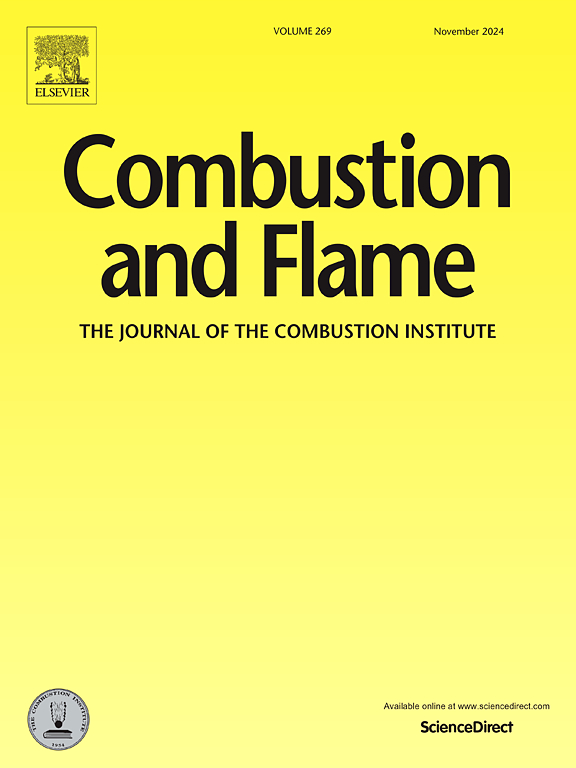Investigation of the pure ammonia flames in a novel two-stage burner
IF 5.8
2区 工程技术
Q2 ENERGY & FUELS
引用次数: 0
Abstract
Ammonia's slow chemical kinetics and fuel-bound NOx emissions present challenges for combustion applications. However, its carbon-free nature, easy storage and transport, and high hydrogen content have attracted growing research interest. To improve the burning efficiency of pure ammonia flames, this study introduces a novel burner design with two reactor sets, aimed at achieving stable ammonia-air flames with reduced NOx zero NH3 slip. Experiments are conducted and successfully stabilised the pure ammonia flames under the wide range of global equvalence ratios (0.3-1.3) and thermal intensities (∼1.5 MW/m3 to ∼9.2 MW/m3). Emissions of NH3, NO, and NO2, along with temperatures at various combustor levels, are measured. Computational simulations using Large Eddy Simulation (LES) are conducted to study flame dynamics and mixing in pure ammonia flames. The results indicated that the new burner design enhanced flame stability (0.3-1.3), improved mixing, achieved nearly zero NH3 slip, and reduced NOx levels in non-premixed ammonia-air flames. Both experimental and predicted data revealed that higher thermal intensities are key to reducing NH3 and NOx emissions across all equivalence ratios. At lower thermal outputs (10 kW and 20 kW), minimal NH3 emissions were noted at rich conditions (1.3), while higher thermal outputs completely eliminated NH3 emissions. The burner's air staging and recuperative design resulted in lower NO emissions compared to previous studies, with the lowest NO levels (420, 302, 390, and 299 ppm) at 10, 20, 40, and 60 kW, respectively, without NH3 emissions. Rich conditions produced well-distributed flames at 40 kW and 60 kW. A chemical reaction network (CRN) analysis showed the influence of O2 availability and thermal intensities on NO emissions, confirming that uniform mixing from tangential air inlets effectively controlled ammonia consumption.
新型两级燃烧器中纯氨火焰的研究
氨缓慢的化学动力学和燃料结合的氮氧化物排放给燃烧应用带来了挑战。然而,它的无碳特性、易于储存和运输以及高氢含量吸引了越来越多的研究兴趣。为了提高纯氨火焰的燃烧效率,本研究引入了一种新的双反应器燃烧器设计,旨在实现稳定的氨空气火焰,减少NOx零NH3的滑落。实验进行并成功地稳定了纯氨火焰在广泛的全球等效比(0.3-1.3)和热强度(~ 1.5 MW/m3至~ 9.2 MW/m3)。测量了NH3、NO和NO2的排放,以及不同燃烧室水平的温度。利用大涡模拟(LES)对纯氨火焰的火焰动力学和混合进行了计算模拟。结果表明,新的燃烧器设计提高了火焰稳定性(0.3-1.3),改善了混合,实现了接近零的NH3滑移,降低了非预混氨-空气火焰中的NOx水平。实验和预测数据都表明,在所有等效比下,更高的热强度是减少NH3和NOx排放的关键。在较低的热输出(10 kW和20 kW)条件下,丰富条件下的NH3排放量最小(1.3),而较高的热输出完全消除了NH3排放。与之前的研究相比,燃烧器的空气分级和回收设计降低了NO排放,在10、20、40和60 kW时,NO水平最低(420、302、390和299 ppm),没有NH3排放。丰富的条件产生均匀分布的火焰在40千瓦和60千瓦。化学反应网络(CRN)分析显示了O2有效性和热强度对NO排放的影响,证实了切向进气道的均匀混合有效地控制了氨消耗。
本文章由计算机程序翻译,如有差异,请以英文原文为准。
求助全文
约1分钟内获得全文
求助全文
来源期刊

Combustion and Flame
工程技术-工程:化工
CiteScore
9.50
自引率
20.50%
发文量
631
审稿时长
3.8 months
期刊介绍:
The mission of the journal is to publish high quality work from experimental, theoretical, and computational investigations on the fundamentals of combustion phenomena and closely allied matters. While submissions in all pertinent areas are welcomed, past and recent focus of the journal has been on:
Development and validation of reaction kinetics, reduction of reaction mechanisms and modeling of combustion systems, including:
Conventional, alternative and surrogate fuels;
Pollutants;
Particulate and aerosol formation and abatement;
Heterogeneous processes.
Experimental, theoretical, and computational studies of laminar and turbulent combustion phenomena, including:
Premixed and non-premixed flames;
Ignition and extinction phenomena;
Flame propagation;
Flame structure;
Instabilities and swirl;
Flame spread;
Multi-phase reactants.
Advances in diagnostic and computational methods in combustion, including:
Measurement and simulation of scalar and vector properties;
Novel techniques;
State-of-the art applications.
Fundamental investigations of combustion technologies and systems, including:
Internal combustion engines;
Gas turbines;
Small- and large-scale stationary combustion and power generation;
Catalytic combustion;
Combustion synthesis;
Combustion under extreme conditions;
New concepts.
 求助内容:
求助内容: 应助结果提醒方式:
应助结果提醒方式:


